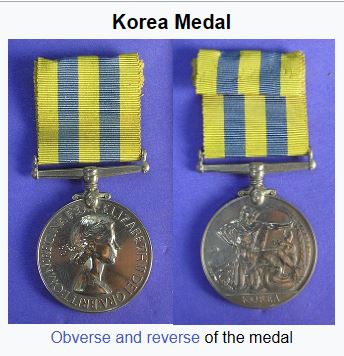Korea Medal
From Our Contribution
 British Commonwealth Korea Medal |
Eligibility
The Korea Medal, sometimes referred to as the Queen's Korea Medal to distinguish it from the United Nations Service Medal, is a campaign medal created in 1951. Members of the British and Commonwealth armed forces were granted the Korea Medal for active service in the theatre of the Korean Peninsula between 2 July 1950 and 27 July 1953. To receive the medal, navy personnel were required to complete either 28 days aboard ship in the operational areas of the Yellow Sea or the Sea of Japan, or at least one day of shore duty; air force personnel needed to complete one operational sortie over the peninsula or the surrounding seas, or meet the same requirements as naval or army personnel; and army personnel must have undertaken a minimum of one day's service on the strength of a unit serving in Korea.
Description
The Korea Medal is in the form of a 36mm (1.4 in) diameter disc of cupro-nickel.
On the obverse is an effigy of Queen Elizabeth II, surrounded by an inscription. At the time of the medal's creation, King George VI was monarch and his effigy was to have appeared on the Korea Medal.n. However, he died on 6 February 1952 and so the image of his daughter was placed on the obverse of the medal, uncrowned, as per custom for sovereigns prior to their coronatio
On the reverse is a depiction of Hercules wrestling the Hydra—a symbolic representation of communism—with the word KOREA below.
Recipients
Notes
Content for the history and honours sections has come from a combination of Wikipedia and the Australian War Memorial websites.